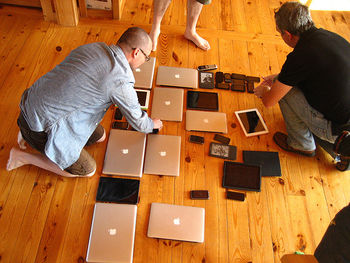 |
| Devices a photo by Adactio |
Our pivotal discussion question was based on a premise mentioned by Noam Chomsky (2010) - "The purpose of education is to help people learn for themselves"..." do you train for passing tests, or do you train for creative inquiry?" He also discusses whether technology for learning is like a hammer - we discussed the two sides of what that means - smashing or building. Check out the full story in his video about the Purpose of Education (prepared for the Learning Without Frontiers conference).
Main points from the discussion
- Technology is changing more rapidly - can give quick knowledge but may not give depth of understanding. For example, video clips of techniques about vet nursing, e.g., blood smear.
- Benefits for hospitality - more collaborative and can share recipes and techniques rapidly.Gives confidence to have a go, and even if make a mistake, the community can help you to understand what might have gone wrong - could potentially deepen knowledge.
- Digital information literacy essential - play is important. Validity of a resource, and currency can be an issue. May find an answer and not necessarily appropriate but just rush it so may accept anything. Not just one textbook now. Teachers are acting as filters of information. Triangulation of sources - three different sources. Request more than one source.
- Reports about trends - Horizon report - predictions technology in next five years, e.g. gamification, and Innovating Pedagogy - educational approaches supported by technology, e.g., seamless learning - anywhere, anytime on mobile devices. Read executive summary then choose a technology or pedagogy in your context and focus on that in more detail in the reports. Details on the wiki page.
- Technology does encourage creative inquiry - need to have the desire to explore.
- Hammer analogy - internet can open doors, ease of getting answer can shut doors.
- Communication with students - how to contact them in a hurry? Moodle, Facebook, Lync, cellphones, telephone, student and personal email. Respond quicker if in trouble or something they need. Is an issue for workload using lots of technologies. Self-responsibility. Why isn't the student taking responsibility?
- Grainne Conole presentation Navigating Digital landscapes - visited Otago Polytechnic in October 2013 - an overview of the two reports and trends in eLearning.
- Online information literacy modules at: http://oil.otago.ac.nz/oil/index/Modules.html
- Self-regulated learner - need scaffolding to develop skills. Novice does not have the skills to plan, monitor and evaluate learning process - need scaffolding to learn to become an expert learner - able to self-regulate, and take responsibility for own learning. See: Expert learners.
- Te Whare Tapa Whā model of learning. Four areas need to be addressed if students are to engage - (cognitive - Taha Hinengaro, spiritual - Taha Wairua, physical - Taha Tinana, and family - Taha Whānau). Explained in Knowing your learner - Engaging Māori learners: an introductory resource for adult literacy and numeracy educators.
- All the links to the video clips are on the left side of the web page. Take particular note of the video about the model of learning for Maori - Te Whare Tapa Whā.
Labels: online discussion, trends
0 comments:
Subscribe to:
Post Comments (Atom)
